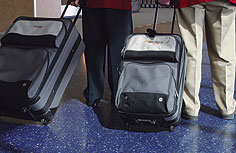 |
|
WHAT'S NEXT? Technology is challenging architecture as the hallmark of terminal design. (Photo courtesy of Foster and Partners) |
Gone are the days of V-shaped runways, quonset huts and complacency, replaced now by parallel runways, plugged-in terminals and uncertainty. Since the first flight by the Wright Brothers a century ago, aviation has evolved from early feats of daring to a multibillion-dollar industry that has relied on equally great feats of engineering and architecture to capture first the imagination and then the expectations of the traveling public.
The Sept. 11, 2001, terrorist attacks and the subsequent recession shook the industry and redefined expectations. Airport improvement projects stalled as security requirements took precedence. Major carriers teetered on the edge of bankruptcy. People were afraid to fly.
Although the 9/11 attacks were the worst catastrophe in U.S. aviation history, its causes and effectshijackings, economic slumps and the rise of low-cost carriershave been seen before and are all milestones of the past 100 years. So are the eventual rejuvenation of commercial flight and the increasingly high-tech art of airport construction.
|
"Change is obvious," says D. Kent Turner, transportation director for St. Louis-based architect Hellmuth, Obata + Kassabaum. Currently, the model is changing for airports to spend less on grand architectural statements and more on concessions, information systems and security systems, he says.
"Wi-fi" and Internet-based technology are already allowing fliers to print boarding passes, check in and pick seats remotely from the terminal. That will expand to include self-printing of baggage tags, separate bag delivery to the airport, electronic ID tags, remote-facility airport screening and biometric identification. The implementation of these methods will affect the physical shape of airport facilities and layout.
Providing those services is key to moving people quickly to their destinations as owners expect to close in on pre-9/11 levels of air traffic in 2004 and 2005.
"In the past 15 to 20 years, we have had strikes, wars and other impacts, and while there are dips, over time we always trend back upward," says Clay R. Paslay, executive vice president of Dallas-Fort Worth International Airport, which is forging ahead with its $2.5-billion program, including a new 2-million-sq-ft terminal. "So, ironically, we feel now is the best time to be developing so that we are out in front of the next wave of growth."
But airports wont look and operate the same as security and the bifurcation of airline philosophy drives changes. Los Angeles International Airports new master plan is a $9-billion, security-focused overhaul backed by Mayor James K. Hahn (D) to create a central passenger pick-up and drop-off area connected to terminals by a people mover. Hahn wants to demolish the airports parking structures and replace them with 6.5 million sq ft of redeveloped terminal space.
Hahn followed that on Dec. 8, announcing the long-planned, $225-million renovation of Tom Bradley International Terminal. The project, separate from the master plan, will include relocation of baggage screening machines, mechanical and electrical upgrades and remodeling.
In the next five years, Airbus 380 double-decker planes will attempt to succeed in hub-and-spoke travel, while Boeing is pinning aircraft development on point-to-point travel. Either way, air-side and terminal-side facilities must be prepared to handle either the 80-person regional jet or the 800-person double-decker jet.
 |
| WAITING Passenger convenience tehnologies will continue to evolve, but the shape of future security concerns is unpredictable. (Photo courtesy of Kansas City Aviation Dept.) |
Some industry veterans caution over extrapolating business and building trends over too long a time. Although "deregulation impacts still resonate, whos going to tell how long before the political situation will change in regard to security?" says airport consultant Yeong Yee. Even the continued growth of low-cost carriers is "a big open question," says Marion Golemis, a veteran aviation planner now retired from the Port Authority of New York & New Jersey. "Any projections of what will happen in the next five years, let alone 10 or 20, is iffy."
A 1950s report by aviation planners with the Port of New York & New Jersey illustrates the point. In 1948, "the airline industry became extremely conservative in estimates of their future. This... prompted a reduction in the plans for a first-stage passenger terminal." Two years later, "optimism...was again on the upswing so that the passenger terminal studies in turn were again in the expansion phase."
The basic challenges that airport builders and designers face in this century are not any different than what their predecessors faced in the last. They face the challenge of being flexible and adaptable to the patterns that occur and recur through the constant evolution of the aviation business.
Click below for more articles from special report "Airports of the Future">>
Design: The Future is At the Gate
International: Global Aviation Takes Off
Security: Baggage Screening Goes In-line, Out of View
Regionals: Reviving with Revisions
Connections: Take the Train to the Plane
Airport Products
